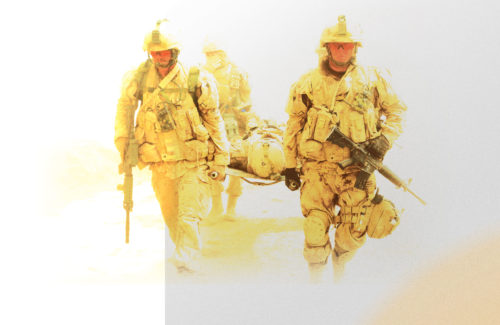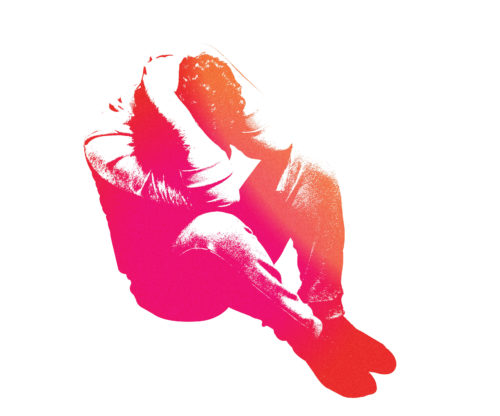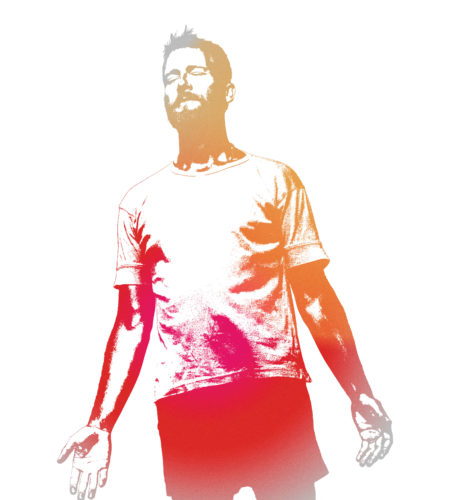
[Illustration sources: iStock]
In 2014, in physical agony and with tortured emotions, Major Mark Campbell left the Canadian Armed Forces. It had been four years since he was targeted in Afghanistan by Taliban insurgents, who triggered an explosion that claimed both his legs above the knee. From that moment, pain has been a constant companion.
Campbell felt like his feet were on fire, although they were no longer part of his body, and for a long time nothing seemed to help much. He became clinically depressed and “took to the bottle for a few years.”
“It has been quite a struggle.”
He is not alone.
Many CAF veterans live with chronic pain. More than 40 per cent of veterans who left the military since 1998 have chronic pain—two to three times the rate of civilians, reported Life After Service Studies. In a mental health survey, 60 per cent reported their pain to be moderate to severe.
Chronic pain and musculoskeletal conditions are the most common causes for medical release of serving personnel, and more than half of veterans who experienced a difficult transition to civilian life have chronic pain. Nearly two-thirds of veterans with chronic pain also have mental health conditions such as depression and anxiety.
“We’re identifying a network…so veterans can get evidence-based care closer to home.”
“Chronic pain is one of the well-being stressors that appears to contribute to suicidal thinking,” said Jim Thompson, retired research medical advisor to Veterans Affairs Canada and an expert on suicide prevention. Chronic physical pain is a feature of life for two-thirds of veterans with serious thoughts of suicide and three-quarters of those who attempt it.
Campbell certainly thought about it, “especially early on. I thought, ‘I can’t live like this.’ I certainly considered suicide as one consequence.
“I tried a million things—natural things, artificial things, devices. I tried massage, needling, intramuscular stimulation, micro-electrical brain stimulation. OxyContin had horrible side effects—I blew up 40 pounds, and it didn’t kill the pain.”
Now “my pain level is two to three [on a scale of 10], just background noise.” That’s unless he misses taking his twice-daily medication cocktail, including one used to treat diabetic nerve damage, anti-depressants, which are also used for pain, and methadone, a synthetic opioid traditionally associated with relief of heroin withdrawal that has gained a reputation recently for chronic pain management.
When Campbell misses his medications, the constant sensation of pins and needles grows and amplifies “until it’s intolerable.”
It took Campbell years of searching to find a pain clinic that worked out a stable medical regime and pain medications that alleviate—but do not eradicate—his pain.

[Adam Day/Legion Magazine]
The Chronic Pain Centre of Excellence for Canadian Veterans, based at McMaster University in Hamilton, Ont., hopes to end this trial-and-error approach by identifying effective evidence-based treatments, recommending standards of care, and sharing that information so it can be rapidly put to use treating veterans.
“Historically, it could be anywhere from 12 to 19 years before there’s broad acceptance of a new model,” said Ramesh Zacharias, the centre’s medical director, president and CEO. “We’re identifying a network of 20 to 25 interdisciplinary pain clinics across the country to work collaboratively so veterans can get evidence-based care closer to home.”
Millions of Canadians struggle with chronic pain, but it is not fully understood how it develops or how best to treat it.
“We spend a lot of [research] money on diabetes, heart disease, cholesterol, cancer—but chronic pain research has been underfunded,” said Zacharias. “In the past it was not recognized as worth pursuing.”
That attitude changed with recognition of its effect on the economy. More than $7 billion is spent in the health-care system managing chronic pain each year—not including what sufferers spend or indirect costs such as lost productivity, reported the Canadian Pain Task Force in 2019. The total economic hit is estimated at up to $60 billion annually.
Canada is investing more money in chronic pain research, including $20.1 million over five years establishing the centre at McMaster and $5 million in ongoing annual funding for its research into innovative pain management therapies.

“One of the things I really like is that veterans were included right from the get-go in development of the centre,” said Ray McInnis, director of Veterans Services for The Royal Canadian Legion, a board director of the centre, and himself a veteran with chronic pain. “If I have a veteran with chronic pain, I can ask what they’re doing for treatment and refer him or her to one of the clinics across the country.
“It’s positive for me as a member of the board, but also for me living with it. I know there will be research that may improve my standard and quality of life as I get older.”
Guiding the centre’s work are two advisory councils—one made up of veterans, the other of scientists.
“What’s exciting to me,” said Tom Hoppe, chair of the veterans’ advisory council, “is it ensures the treatment that’s going to happen has actually been vetted, researched, and we know it’s going to work.” Hoppe had a 20-year military career that ended in 2002, leaving him searching for ways to manage chronic pain. Now he’s glad of the opportunity to inform other veterans.
“They’re taking the ‘whole person’ approach and looking at every possible angle, not just traditional pharmaceuticals,” said veteran Arron Victory of Oromocto, N.B. “They’re coming at this from any angle that’s going to provide tangible benefits to veterans.” And their families.
“Veterans are more interested in research that will be directly applicable to care,” said Jason Busse, the centre’s research director.

The centre opened officially in May, and in August a team of researchers led by Busse had two papers published in the Annals of Internal Medicine. One presented evidence that veterans are at higher risk for prolonged opioid use after acute injury, and the second that opioids are no more effective than less-addictive treatments, such as anti-inflammatories, and cause more negative side effects.
Many studies conducted by the pharmaceutical industry show the effectiveness of opioids compared to placebos, which have no therapeutic effect, said Busse, and fewer compare the effect of opioids with alternate treatments. As well, manufacturers focus on statistically significant effects, but patients may not consider some effects significant enough to warrant the risks.
This research can be immediately useful to veterans considering alternatives for pain medication and those who treat them, who are encouraged to limit opioid prescriptions to less than one week following an acute injury, and to consider not represcribing them to high-risk veterans.
The centre is also studying the use of cannabis for chronic pain.
“It’s now legalized,” said Zacharias, “and more than 10,000 veterans are consuming cannabis, but we really don’t know the impact of it, who’s benefiting, who’s showing signs of harm.” Veterans Affairs Canada reimbursed just over $85 million for medical cannabis in 2019.
“I’d like to see more research on medicinal marijuana, chronic pain and mental health,” said McInnis. “What are the long-term effects? Is it working? Does it react with other medications? You can go into a pharmacy right now and say, ‘I’m taking medical marijuana’ and ask how does it interfere with drug x or y? And they can’t tell you.”

The centre is surveying veterans with chronic pain across the country to help establish research goals.
So far, four major themes have emerged, said Busse—prevention of chronic pain, improving care and the co-ordination of care, and assistance sorting out the wide range of treatment options.
“Veterans see five health-care providers and they’d get five different recommendations,” said Busse. “They go on the internet and there’s 50 different things. They say, ‘Tell me what is most likely to work so I don’t have to take years to find something that helps.’”
Signposts are welcome, said Hoppe. “When you’re in a closed society like the military, a lot of things that are available are not widely known. We’ve heard stories of veterans who said they didn’t even know how to find their own doctor, let alone research finding a pain clinic. The centre is educating veterans.”
The opioid crisis has sparked interest in research into non-pharmacological approaches to treating acute and chronic pain.
The centre is involved in an international trial that will enrol between 800 and 1,000 people undergoing surgery in the Netherlands and more than a dozen sites across Canada. Half will get usual post-operative care; the other half will do online cognitive behavioural therapy and relaxation techniques.
“We’ll see if we can reduce the rate at which patients develop chronic pain,” said Busse. “If it works, it would be not that expensive and it could be made available to veterans no matter what theatre they’re serving in, so long as they had internet access.”
The breadth of the research impresses Victory, who served in infantry and sniper subunits for 14 years.
“I speak for my generation, younger veterans who are more open to less traditional modalities [such as] hot yoga, meditation, breath work, cannabis…rather than pharmaceuticals.”
Chronic pain eats away at the things that contribute to well-being, jeopardizing jobs and careers or one’s purpose in life, threatening financial security and mental health, interfering with participation in community life and shrinking social life.
That’s why a holistic approach is needed both in care and research care, said Victory, because “you might have chronic pain, but also PTSD, traumatic brain injury or other ailments. And chronic pain doesn’t happen in a bubble. It affects the family, the spouse, the children.”
“You can do all the physio you like,” said Hoppe, “but if you’re not sleeping well or eating properly or don’t have a purpose or goal in life, it puts you in a depressive zone and it affects your chronic pain.”
“The Chronic Pain Centre of Excellence for Canadian Veterans is long overdue,” said Campbell. “It’s not that veterans have a corner on chronic pain, but we are a ready-made market for new treatments, and we come with a pot of research money.” And once the centre establishes best practices, “we can share that information with everyone.”
Healing with pain
Human beings couldn’t survive without pain. It’s a built-in emergency response system. Nerves instantly alert the brain of damage or danger to tissue, and the brain immediately shoots back a message for action.
Burn your hand and you flinch to avoid further damage. Cut a finger and pain draws attention to a wound that needs attending. Twist an ankle or break a bone and pain stops you from using the affected limb until it heals.
Pain information goes to parts of the brain that help control mood, sleep and hormone activity, so along with the pain may come sensitivity to noise and light, say, or an urge to sleep. Some people become more emotional, cry easily or get grouchy. Anxiety and depression can set in when pain persists.
The unpleasantness of pain—burning, throbbing, stabbing, itching—generally eases off as the body heals.
But humans sometimes have to live with chronic pain that lingers long beyond the usual healing time. Sometimes there’s been damage to the nervous system, as with spinal cord injuries, or traumatic brain injuries, amputations, diabetes. Persistent inflammation can also lead to chronic pain. And sometimes the cause can’t be determined.
MRI scans show abnormal stimulation in the brains of those with chronic pain, causing sufferers to feel pain more intensely. Some sufferers may become so sensitive that even a gentle touch hurts.
“You can’t see it,” said Ramesh Zacharias of the Chronic Pain Centre of Excellence for Canadian Veterans. There is no test to detect it or tool to measure it. Too often, chronic pain sufferers are told ‘it’s all in your head.’ Consequently, “people suffer in silence.”
“We’ll see if we can reduce the rate at which patients develop chronic pain.”
For decades, medical researchers have thought something goes wrong with the messaging system so that pain is maintained or amplified by repeated nerve stimulation that increases sensitivity or makes the pain last longer. If you can stop the messages, you can stop the chronic pain.
“If we think of it as an active process, something is still going on and we need to suppress it so the pain can stop,” said Norm Buckley, the centre’s scientific director. “That’s the idea behind narcotics as pain killers, anticonvulsants to stop unusual nerve activity, steroids to stop inflammation.
“But maybe that’s not the case at all. The brain has multiple ways to drive the recovery process, but if many of them fail, you may not get a good recovery; it’s not that something wrong is continuing to happen, it’s that you haven’t laid down the correct recovery patterns.”
This may explain the success of the multidisciplinary biopsychosocial approach to chronic pain management that involves medicine, rehabilitation and cognitive behavioural therapy.
“Pain is a physical and emotional sensation,” said Buckley. “We describe emotional blows as like being punched in the gut.” And pain certainly affects mood, causing anger, depression and anxiety. Mood is key to the response to chronic pain.
“Do you reorganize yourself and get on with life, or pull back and stop doing everything?” said Buckley.
When on medical leave or medical release, veterans “have lost their whole social structure. They no longer have interactions with familiar people and they often don’t have a reason to get up in the morning. If they didn’t have a psychological problem before, now they have one. They become angry and isolated.
“Chronic pain affects everything about you—work, energy, mood, family. You don’t go out anymore. The kids can’t react with a parent who has withdrawn. In this complicated situation, you need a whole team of people pulling together.”
World of pain
Many researchers around the world are searching for a way to lessen—and even cure—chronic pain.
Researchers at the Hotchkiss Brain Institute in Calgary and Stanford University in California have found that chronic pain alters the network of receptors running through the nervous system to the brain. Targeted brain stimulation has stopped the pain—in mice. But such treatment for humans is years or decades away.
Virginia Tech School of Neuroscience researchers are developing a non-opioid drug that targets an enzyme that contributes to chronic pain but does not respond to over-the-counter pain relievers.
A certain protein that shapes the body’s response to stress also drives chronic pain, researchers at University College London have found. Using a drug designed for treating mood disorders also substantially relieves pain—again in mice. Human trials to follow.
Researchers are investigating the role of what we eat—or don’t eat—in developing and influencing chronic pain. Research in Kenya found that cutting monosodium glutamate from the diet helps. So does diet therapy, including lowering inflammation, supplementing certain vitamins, minerals and fatty acids, using probiotics, and therapeutic fasting, say researchers at the Centre for Pain Research in Leeds, U.K.
A University of Copenhagen team has spent a decade designing and developing a compound that targets dysfunctional nerves that cause pain. They found it cured mice of chronic pain, with no side-effects, and now are moving on to human trials.
Some of the research is applicable to veterans now, but it may take decades for other discoveries to make their way into common use.
Advertisement





















